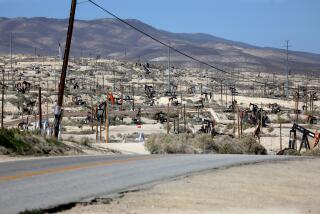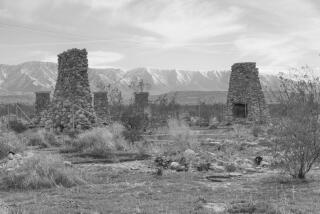There’s No Love Lost for Entrepreneur Who Envisioned Model City : Environment: Most historians contend his plan for a metropolis on the shores of Niagara River was never more than a con. Others call him naive. The unintended result was Love Canal.
- Share via
MODEL CITY, N.Y. — Humming “Yankee Doodle,” William T. Love came to town a century ago as a Pied Piper for a harebrained scheme to use the water power of Niagara Falls to create a utopia.
A shadowy entrepreneur, Love envisioned an industrial city of 2 million people rising out of the orchards and fields of Lewiston, where the Niagara River flows into Lake Ontario north of Niagara Falls.
Instead, Love’s vision left two decidedly un-utopian legacies: a dump where radioactive waste from the Manhattan Project was stored and a ditch that keeps his name alive today--Love Canal, one of the nation’s most notorious chemical landfills.
A century after Love showed up, the site of his dream is little more than a rural road with a few dozen families. There’s a garbage landfill and a bar--both ironies, since Love had counted on an environmentally spotless town populated by teetotalers.
“Love was kind of naively utopian, if that makes any sense,” said amateur historian Daniel Dumych of nearby North Tonawanda. “Being a non-technical person, he hoped for more than was possible. He dreamed too big for the time and came off looking like a charlatan.”
Love spent a few years in the area in the 1890s, snatching money from gullible investors, mapping out his dream city and acquiring rights to more than 20,000 acres. After the depression of the mid-1890s, Love skipped town--the money for his scheme either spent or packed away in a suitcase. No one knows for sure.
“The people that would know are dead,” said Dick Cary, Lewiston town historian. “I suppose, in a sense, he was a con man. A con man thinks about not what he can do, but what he can get. But I do think he had a good idea there. If he’d had the money, he might have done it.”
In late 1892 or early 1893, Love came to Niagara Falls and became intrigued with the hydropower potential of the waterfalls. The Niagara River had been tapped for its water power as far back as 1757 to run a sawmill. Several small hydroelectric projects preceded Love’s arrival.
Love planned to dig a canal from the upper Niagara River in Niagara Falls to Lewiston, seven miles downriver. The water would tumble over a 300-foot escarpment, powering hydroelectric turbines at Model City.
“From an engineering standpoint, it was entirely practical, but this Model City seemed a little bit idealistic to me,” said D. George Vanderhoek, a Lewiston resident who has researched Love’s plan.
Love apparently had P. T. Barnum’s gift of persuasion, for within months the local newspapers were carrying almost daily updates on the plan. The New York Legislature granted Love sweeping powers to condemn and take over any property he needed.
Gov. Roswell Flower, in signing the legislation, predicted Model City would grow to 2 million inhabitants. Love himself said there would be 200,000 people there by the early 1900s.
Love lured a few factories to Model City by offering them free power. Someone wrote a pep song to the tune of “Yankee Doodle”: “They’re building now a great big ditch through dirt and rock so gritty, they say ‘twill make all very rich who live in Model City.”
Love foresaw perfect streets, perfect schools, perfect factories, perfect sanitation--in short, a model city. In their deeds, landowners had to swear they would never sell alcohol.
On May 23, 1894, work on the canal began in Niagara Falls. Digging continued fitfully for a few years, then was abandoned after about a mile of Love’s canal had been dug.
Niagara Falls children used Love Canal as a swimming hole until the 1940s, when Hooker Chemical & Plastics Corp. began using it as a dump. In the late 1970s, a health emergency was declared because of chemicals leaking from Love Canal. Hundreds of families were evacuated.
“Nowadays, when anybody remembers William Love, they think of that mess in Niagara Falls,” said Betty Phippen of the Lewiston Historical Museum. “But that had nothing to with Love’s scheme.”
Model City’s one flurry of industrialism came during World War II, when the federal government built a dynamite factory there. Radioactive waste from the Manhattan Project that built the atomic bomb also was dumped at Model City.
“I think Love would be horrified at what happened to his land,” said John Kohl, chairman of a citizens’ environmental group in Lewiston. “This is destructive, and he was a constructive man.”
It’s unclear where Love came from. Newspapers alternately said he came from Knoxville, Tenn., New England or, simply, from “the West.” Love told Model City investors he single-handedly brought 15,000 settlers to Guthrie, Okla., during a land boom in the 1880s.
Michael Bruce, curator of the Oklahoma Territorial Museum in Guthrie, said he had never heard of Love and could find no mention of him in local history books.
At Model City, Love raised hundreds of thousands--perhaps millions--of dollars. He would periodically disappear, claiming he was on business trips to London to attract foreign investment, though there was no evidence he ever left the country.
“Love sold a bill of goods to a lot of innocent people,” said Donald Loker, local history curator at the Niagara Falls Library. “He dug a hole, then he left town.”
The 1890s depression dried up Love’s investments. Then Nikola Tesla developed alternating current, electricity that could be transmitted hundreds of miles, freeing industry from locating near power sources such as Niagara Falls.
Love’s plan died for good in 1907, when Congress passed the Burton Act, which prohibited further diversion of water from Niagara Falls. By then, several large hydroelectric plants were operating there, proving that Love’s idea had been viable.
“Perhaps we’re lucky he failed,” said Lewiston Town Supervisor Thomas Sharp. “Lewiston is a quiet, residential area. We like it that way.”
In 1910, the Niagara County sheriff foreclosed on the last Model City land and auctioned if off.
Love was long gone by then. There were rumors he joined the Alaska gold rush.
“He disappeared from the face of the earth,” said Ralph Love of nearby Ransomville, whose great-grandfather was William Love’s cousin.
A decade ago, Ralph Love worked on the cleanup at Love Canal. He said he used to joke with co-workers that the family had finally made some money on the ditch.
And William T. Love?
“He probably died a heartbroken man,” historian Dumych said. “He had a chance to change the world, and it didn’t work.”
More to Read
Sign up for Essential California
The most important California stories and recommendations in your inbox every morning.
You may occasionally receive promotional content from the Los Angeles Times.







